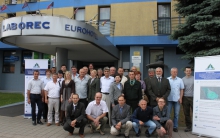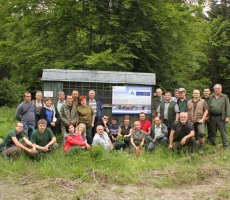
Joint field seminar on issues of hydrological role of forests and flood protection measures and approaches of forest management, which enhance hydrological functions and decrease flood risks, was held on June 24-25 in vicinity of Medzilaborce town in Slovakia. Field part, targeting foresters and stakeholders, took place mainly at forest lands of state forest management enterprise Vranov.
The seminar has gathered representatives of National Forest Center in Zvolen, the Academy of Science of Slovakia in Bratislava, State Agency of environment protection, forest management enterprise Vranov – from Slovakia, and representatives of FORZA NGO, UkrRIMF, Zakarpattya regional forest and hunting administration, Brustury, Perechyn and Velykyi Bereznyi state forest enterprises and NNP “Zacharovanyi Krai” – from the side of Ukraine.
First of all, participants were informed about results of scientific researches and practical projects, aimed at enhancement of hydrological role of forests at the territory of Slovakia. In the welcome speech, the director of forestry research institute of National Forest Center, Tomash Bukha mentioned, that the HYDROFOR project is focusing its attention on wider context of forest functions use. Enhancement and use of forest functions are on the list of main issues, considered by international forums and organizations, such as FAO, IUFRO, European Institute of Forests, and which are included to the political processes and initiatives, particularly European Forest Strategy and Action Plan, UN Forum of Forests, Ministerial conference on protection of forests of Europe, Convention on Biodiversity and International cooperation programs as HORIZONT 2020. Common idea of these strategic documents is introduction of the concept of optimal, continuous and sustainable forest management with emphasis on balance in economic, environmental and social functions of forests.
One of the most important functions of forests are hydrological, and that became the reason of HYDROFOR project implementation, main activities and results of which were presented by Ivan Barka. Among them – modelling of flood risks depending on condition of forest ecosystem as a whole and its separate components, which became a basis for development of the recommendations for forestry practitioners and managers on the optimal methods of forest management and technologies of forest management interventions and implementation of flood prevention activities on forest areas.
Very clear and understandable presentation of “Impact of forests and forest soils on water flow from the watershed” was delivered by Viliam Novak, head of soil hydrology division at the Academy of Science of Slovakia, who explained peculiarities of hydrological functions performance by the forests depending on type of soil, specie and age structure, as well as types of precipitation and generated flood.
Interesting presentation was of Vincent Perzhel, who presented idea and implementation of the project Ondava for Living, aimed at construction of small-scale water retention measures and slowing down water flow at the local, level. The project was co-funded in equal parts by Norwegian Government and Slovakian Ministry of Labour, Social Affairs and Family, and significant portion of funds was directed to creation of jobs for unemployed local population for the implementation of the project’s measures. In the project Ondava for Living equally important are social effect along with environmental and economic, because enhancement of flood protection at the local level prevents economic and ecological losses and ensures social stability.
Up-to-date approaches of laser scanning of forest areas for inventory of forest transportation network and condition under the trees canopy were presented to participants by Ivan Sachkov, expert of National Forest Center.
Participants of the seminar received information about state forest management enterprise Vranov from the deputy director of the enterprise, Pavel Zhatko. Cadastral area of the enterprise covers 200 thousand ha, out of it 44 961 ha – lands under forest management, located in watershed of Topla, Ondava, Laborets, Cirokha and Udava rivers. Altitude varies from 118 m to 1092 m.a.s.l. Specie composition is beech (78%), oak (6%), pine (5%), hornbeam (4%), other: birch, trembling poplar, maple, ash, spruce, fir, larch (7%). The enterprise is composed of 9 forest divisions and employs 146 staff members. Annual harvesting volume is 227448 m3, of them 93,7% - broadleaved species. Main activities of the enterprise are an integral parts of multifunctional forest management, among which are: establishment, nursing, growing and protection of forest stands; harvesting, skidding, manipulation of timber; selling of raw timber, honey and game; hunting; transfer and accommodation services; ensuring conditions for biodiversity preservation.
Field seminar program consisted of visits to the forest areas and settlements, where it was possible to observe and discuss various flood prevention and protection measures and approaches, namely participants have visited:
Palota fir forest – National Nature Reserve, declared in 1982 with the goral to protect natural old-growth fir beech forests with fir of natural origin, at the area of 157,15 ha. Beautiful samples of fir-beech forests with adding of maple, elm and ash.
Forest stands above the Palota village with total area of 400 ha, forest management of which is done with the gradual forest regeneration cuts with the goal to convert them to close to natural forests, which, in turn, are the best from the point of view of hydro-regulating functions performance. Skidding trails and technological corridors in these forests are organized in advance (year before the planned harvesting, during this time skidding trail gets stabilized with the vegetation), which, together with systematic drainage, prevents erosion of soils at the plots. Also at these plots it was possible to see how small streams and wet areas crossings are solved with use of local materials.
Special attention was paid to forest roads, skidding trails and technological corridors, as they significantly impact surface flow of rain water and generation of floods and therefore it is extremely important to plan and maintain them properly. It was compared how transportation lines are used by caterpillar and wheel forest tractors; observed methods of slope enforcement and prevention of landslides and erosion at the sides of forest roads.
During two days of the seminar there were many discussions among Ukrainian and Slovakian participants, which have helped to understand issues, interpret approaches, make conclusions, and, we hope, take further right managerial and practical decisions.
Professional forestry discussion will be extended on July 7-8 during joint field seminar at the territory of Uzhhorod, Perechyn and Velykyi Bereznyi districts of Zakarpattya.
Photos you will find at the adress: https://picasaweb.google.com/113805013373103711164/Medzilaborce_slovakia...






